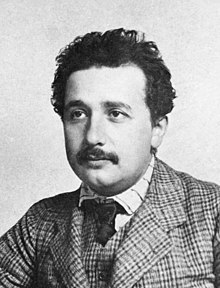狹義相對論

狹義相對論(粵拼:haap3 ji6 soeng1 deoi3 leon6;英文:special theory of relativity)係由歐拔·愛因斯坦喺20世紀初諗出嚟嘅一個現代物理學理論,集中於分析當時已知嘅物理法則喺物件移動速度接近光速嗰陣點解會唔再啱用:自然現象冚唪唥都係由發生喺時空某啲點當中嘅一連串事件組成嘅;喺古典力學裏面,牛頓將絕對空間想像成永遠唔會郁嘅嘢,以及將時間想像成對全宇宙所有物件都一樣、永遠衹向一個方向前進嘅一個量[1][2]。但廿世紀初嘅一啲實驗證據顯示,牛頓嗰套係唔掂嘅,於是愛因斯坦就喺 1905 年諗出咗狹義相對論,解釋牛頓嗰套理論解唔掂嘅結果[3][4]。
概論
[編輯]喺愛因斯坦個原版論文當中,狹義相對論成個理論建基於兩個諗頭[5]:
呢兩個諗頭直接否定咗牛頓個諗法:根據牛頓嗰套理論,如果有兩個唔同參考系當中嘅觀察者,兩個參考系嘅速度唔一樣,佢哋一齊觀察同一束光,兩者所觀察到嘅嗰束光嘅速度會係唔一樣嘅[5]。
然後,愛因斯坦運用呢兩個諗頭做公理,再加埋第啲物理定律,證明咗一柞方程式,而呢柞方程式唔單衹成功噉解釋到牛頓力學解唔到嘅結果,仲可以推理出好多重要嘅定律,包括咗:
- 時間膨脹:兩個一樣嘅時鐘,兩者之間嘅相對速度唔等如零,佢哋量度到嘅時間會唔一樣;
- 長度收縮:一個觀察者量度一件同佢相對速度非零嘅物件嘅長度,佢度到嘅長度會同細過件物件嘅真實長度;
- 相對質量:一個觀察者量度一件同佢相對速度非零嘅物件嘅質量,佢度到嘅質量會同大過件物件嘅真實質量;
- 質能等價:物質同能量本質上係同一樣嘢,;
- 宇宙速度極限:宇宙入面,物件最大嘅可能速度係光速;
... 等等。要留意嘅係,上述呢啲現象要喺物件速度接近光速嗰陣先會睇到[6][7]。
狹義相對論之所以係「狹義」,係因為佢查實淨係考慮到「時空係平坦」(時空冇乜曲率;閔考斯基時空)嗰陣嘅特殊情況:根據打後嘅研究,當時空有顯著嘅曲率嗰時,會出現強勁嘅重力,而強勁嘅重力-好似係由黑洞所施嘅重力-會影響狹義相對論嗰柞方程式嘅準確性;因為噉,愛因斯坦喺 1915 年諗出咗廣義相對論(general theory of relativity)-廣義相對論有考慮時空曲率同重力,所以能夠喺時空唔平坦嘅情況下(例如係所分析嘅物件附近有個黑洞)做出準確嘅預測,對於現代天文物理學嚟講不可或缺[8][9]。
兩大基本命題
[編輯]實驗證據
[編輯]相對原則
[編輯]羅倫斯轉化
[編輯]重要現象
[編輯]睇埋
[編輯]文獻
[編輯]教科書:
- Einstein, Albert (1920). Relativity: The Special and General Theory.
- Einstein, Albert (1996). The Meaning of Relativity. Fine Communications. ISBN 1-56731-136-9
- Logunov, Anatoly A. (2005). Henri Poincaré and the Relativity Theory (transl. from Russian by G. Pontocorvo and V. O. Soloviev, edited by V. A. Petrov) Nauka, Moscow.
- Charles Misner, Kip Thorne, and John Archibald Wheeler (1971). Gravitation. W. H. Freeman & Co. ISBN 0-7167-0334-3
- Harvey R. Brown (2005). Physical relativity: space–time structure from a dynamical perspective, Oxford University Press, ISBN 0-19-927583-1; ISBN 978-0-19-927583-0
- Sergey Stepanov (2018). Relativistic World. De Gruyter. ISBN 9783110515879.
- Taylor, Edwin, and John Archibald Wheeler (1992). Spacetime Physics (2nd ed.). W.H. Freeman & Co. ISBN 0-7167-2327-1
- Tipler, Paul, and Llewellyn, Ralph (2002). Modern Physics (4th ed.). W. H. Freeman & Co. ISBN 0-7167-4345-0
期刊文章:
- Alvager, T.; Farley, F. J. M.; Kjellman, J.; Wallin, L.; et al. (1964). "Test of the Second Postulate of Special Relativity in the GeV region". Physics Letters. 12 (3): 260. Bibcode:1964PhL....12..260A. doi:10.1016/0031-9163(64)91095-9.
- Darrigol, Olivier (2004). "The Mystery of the Poincaré–Einstein Connection". Isis. 95 (4): 614–26. doi:10.1086/430652. PMID 16011297.
- Wolf, Peter; Petit, Gerard (1997). "Satellite test of Special Relativity using the Global Positioning System". Physical Review A. 56 (6): 4405–09. Bibcode:1997PhRvA..56.4405W. doi:10.1103/PhysRevA.56.4405.
引用
[編輯]- ↑ Arnol'd, V. I. (2013). Mathematical methods of classical mechanics (Vol. 60). Springer Science & Business Media.
- ↑ Knudsen, Jens M.; Hjorth, Poul (2012). Elements of Newtonian Mechanics (illustrated ed.). Springer Science & Business Media. p. 30.
- ↑ Einstein, A., Lorentz, H. A., Minkowski, H., & Weyl, H. (1952). The Principle of Relativity: a collection of original memoirs on the special and general theory of relativity. Courier Dover Publications. p. 111.
- ↑ Edwin F. Taylor & John Archibald Wheeler (1992). Spacetime Physics: Introduction to Special Relativity. W. H. Freeman.
- ↑ 5.0 5.1 Albert Einstein (1905) "Zur Elektrodynamik bewegter Körper", Annalen der Physik 17: 891; English translation On the Electrodynamics of Moving Bodies by George Barker Jeffery and Wilfrid Perrett (1923); Another English translation On the Electrodynamics of Moving Bodies by Megh Nad Saha (1920).
- ↑ Albert Einstein (2001). Relativity: The Special and the General Theory (Reprint of 1920 translation by Robert W. Lawson ed.). Routledge. p. 48.
- ↑ Richard Phillips Feynman (1998). Six Not-so-easy Pieces: Einstein's relativity, symmetry, and space–time (Reprint of 1995 ed.). Basic Books. p. 68.
- ↑ Koks, Don (2006). Explorations in Mathematical Physics: The Concepts Behind an Elegant Language (illustrated ed.). Springer Science & Business Media. p. 234.
- ↑ Steane, Andrew M. (2012). Relativity Made Relatively Easy (illustrated ed.). OUP Oxford. p. 226.


